Last updated on February 27th, 2021
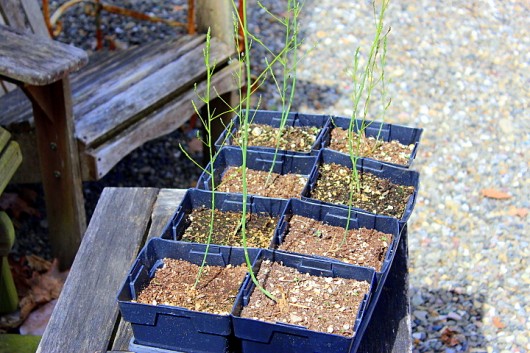 I stopped by my favorite farm store the other day, with the sole intention of buying one (just one!) bag of organic parsley. I purchased the $2.00 herb, and then wandered into one of the farm’s solar-heated greenhouses. There, sitting on a black, tarp-covered floor, and sprouting green, ferny growth, were dozens of asparagus plants. I plunked down an addition $42.00, and brought them home.
I stopped by my favorite farm store the other day, with the sole intention of buying one (just one!) bag of organic parsley. I purchased the $2.00 herb, and then wandered into one of the farm’s solar-heated greenhouses. There, sitting on a black, tarp-covered floor, and sprouting green, ferny growth, were dozens of asparagus plants. I plunked down an addition $42.00, and brought them home.
What does asparagus want? A permanent home where it can live for about 20 years. Consequently, you have to be careful about site selection. The crop performs best in all-day sunshine, and in light, friable, well-draining soil. A raised bed is recommended.
Although it will grow from seed, asparagus is usually obtained from 1-year-old roots, or crowns. Here in New York’s Hudson Valley (zone 5-b), the crowns — whether purchased in pots or loose in bags — are best planted out in early to mid-April.
I decided that a raised bed in my Kitchen Garden would make the ideal home for my perennial guests. The raised bed is 8 feet long, 4 feet wide, and consequently large enough to accommodate 8 asparagus plants.
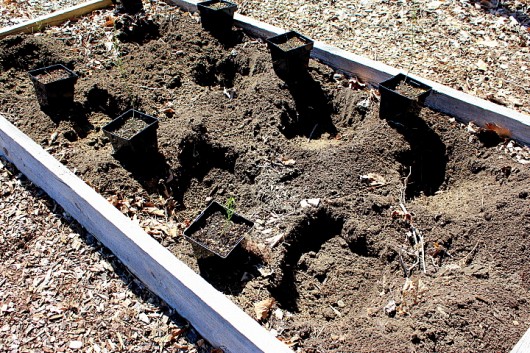 First, dig holes to a depth of 6-8 inches, spacing them 1 1/2 – 2 feet apart.
First, dig holes to a depth of 6-8 inches, spacing them 1 1/2 – 2 feet apart.
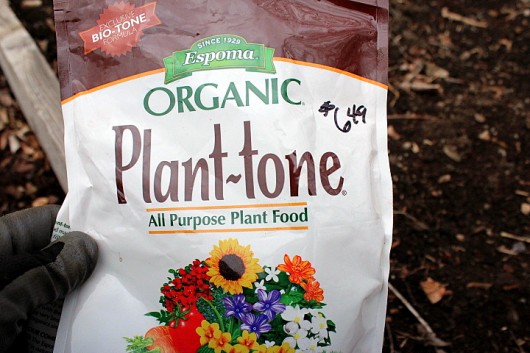 Then drop a handful of some balanced (or nearly-balanced) organic fertilizer into the bottom of the hole.
Then drop a handful of some balanced (or nearly-balanced) organic fertilizer into the bottom of the hole.
 Mix the fertilizer into the soil with your gloved hand.
Mix the fertilizer into the soil with your gloved hand.
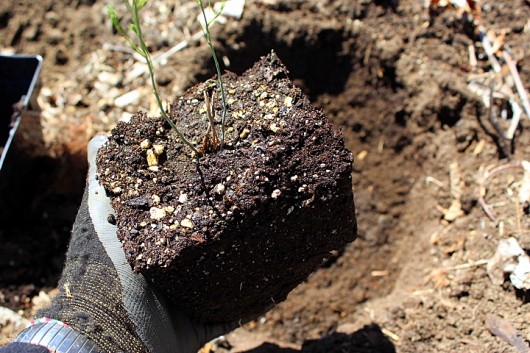 Next, knock the plant from its plastic prison…
Next, knock the plant from its plastic prison…
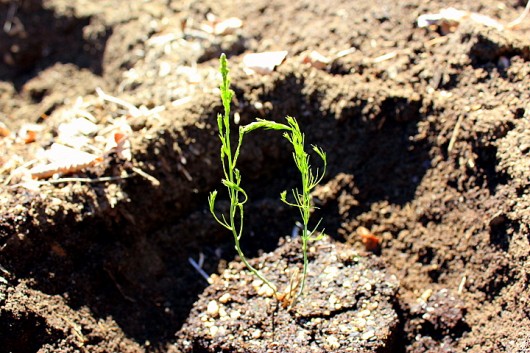 And place it in the hole. If your soil is light and friable, position the plant so that it sits 2 inches deeper than the top of the hole. If your soil is on the heavy side, arrange the plant so that it is level with the raised bed.
And place it in the hole. If your soil is light and friable, position the plant so that it sits 2 inches deeper than the top of the hole. If your soil is on the heavy side, arrange the plant so that it is level with the raised bed.
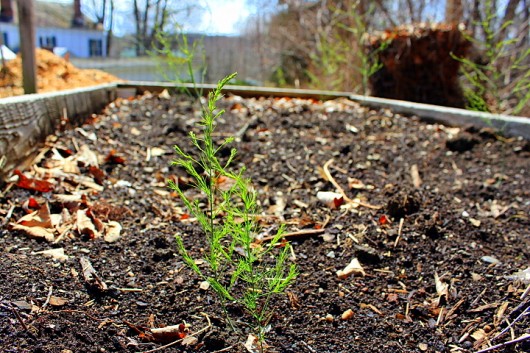 Back-fill the gap around the plant, and admire your work.
Back-fill the gap around the plant, and admire your work.
BUT KEVIN, I PURCHASED LOOSE CROWNS IN A BAG! HOW THE HECK DO I PLANT THEM? I DARE YOU TO RESPOND. SINCERELY, GLADYS K.
 Hi Gladys. First, please don’t use that tone of voice with me. And next, you should plant your crowns in the same fertilized holes described above. Set the crowns in the holes, and spread their roots out horizontally. If you are blessed with loose soil, plant each crown 6 inches deep. In heavy-ish soil, position the crown so it is only 4 inches deep. From sources I’ve read, you can either refill the holes gradually, or all at once. Both of these back-filling methods produce identical results.
Hi Gladys. First, please don’t use that tone of voice with me. And next, you should plant your crowns in the same fertilized holes described above. Set the crowns in the holes, and spread their roots out horizontally. If you are blessed with loose soil, plant each crown 6 inches deep. In heavy-ish soil, position the crown so it is only 4 inches deep. From sources I’ve read, you can either refill the holes gradually, or all at once. Both of these back-filling methods produce identical results.
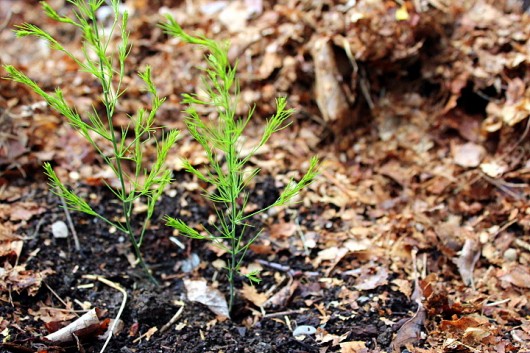 And finally…water the plants deeply, and apply 2 inches of mulch around (not on top of) the plants. Good mulch choices for asparagus include shredded leaves, chopped, weed-free straw, pine needles (contrary to popular belief, these do not acidify the soil), and shredded wood chips.
And finally…water the plants deeply, and apply 2 inches of mulch around (not on top of) the plants. Good mulch choices for asparagus include shredded leaves, chopped, weed-free straw, pine needles (contrary to popular belief, these do not acidify the soil), and shredded wood chips.
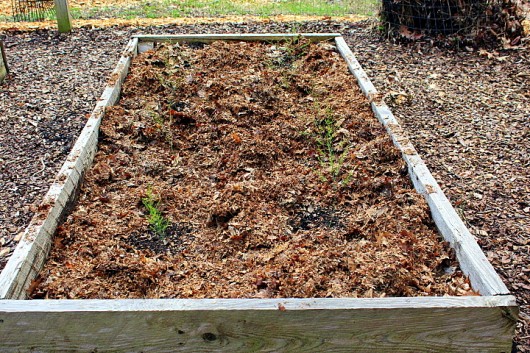 Unfortunately, my asparagus patch won’t be ready for harvest until the plants have grown for 2 years. And that’s okay. It’s always fun to have something to look forward to!
Unfortunately, my asparagus patch won’t be ready for harvest until the plants have grown for 2 years. And that’s okay. It’s always fun to have something to look forward to!
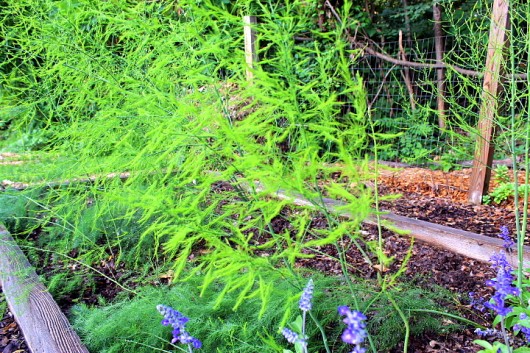 Update: Here’s the same bed, just 3 months after planting. Wowzers!
Update: Here’s the same bed, just 3 months after planting. Wowzers!
In the comments field below, let me know if you’ve tried your hand at asparagus-growing. Perhaps you have some cultural tips and tricks that will benefit us “newbies.”
Don’t miss anything at A Garden for the House…sign up for my email updates.
Related Posts:
Bacon-Wrapped Asparagus
The Best Asparagus Tart in the World
A Water-Wise Way to Plant Potatoes

Erin says
Am I really first?! This is a great how-to on asparagus Kevin. I look forward to watching your bed develop. 🙂
David says
$42 for these small plants? Is any body else blown away with the prices at the garden centers lately. But, an investment of $42 for 20 years of free pickings….might just be worth it. Good information as usual.
LilyGrace says
My grandfather and my father both had the most amazing vegetable gardens — and yes, they always had asparagus — year after year. I imagine by now their beautiful vegetable gardens have been turned over and some other person is growing grass where their vegetables were.
Louise Brouillette says
I do grow asparagus, and I noticed that one of the plants is coming up now. My plants are in their 4th summer, so I hope to harvest more spears, but I freely admit that I’m a lazy gardener and probably have not paid enough attention to them over the years. Yours, I’m sure, will do fabulously, since you’re definitely not as lazy as I am, LOL!
Mary Anna says
$42 for eight, so just over five dollars a plant – that’s a screaming deal, I think, for potted ones. Started a bed last spring, and I’m seeing new spears this week – so fun!
Mermaid Deb says
I have an asparagus bed that has been producing for at least 20 yrs as far as I have been able to establish. I have so much asparagus that I have to give a lot to my neighbors. I don’t tend to it very much at all. I just pick it and let the ferns dry out in the fall before I trim them back for the winter. Good luck, Kevin. The asparagus is so worth the wait.
Cheryl says
I planted my four plants 3 years ago. I got about one pound last year, I’m hoping to get a little more this year.
Mary in Iowa says
I planted an asparagus bed years ago from packaged roots. The plants did beautifully for about 4 years, producing lots of delicious spears. Then, from who knows where, an infestation of asparagus beetles left their calling cards–scads of black eggs stuck with a glue-like substance to every stalk. They are almost impossible to remove, even with a stiff brush, and the spear suffers damage in the process. Yes, one could argue that the cooking would kill the eggs and add a dash of protein to the meal, but the presentation leaves a good bit to be desired. After fighting the problem for 3 more years, I ripped out the bed and haven’t given it another go, though I keep telling myself it’s time. If there’s an organic solution to keeping a bed beetle free, I’m all ears.
Carolyn says
Well I am a stupid gardener as I planted Asparagus last year and when nothing happened I ripped them out. Then this year I noticed a few that remained had popped up so I looked it up and realized you don’t get anything from them for a few years! Lucky I missed some and I am going to let them grow in peace.
Marcy says
We had asparagus growing in the side lawn when i was growing up. I didn’t particularly appreciate it back then when my Dad brought it in each spring for dinner, but I would like to try growing it now. Thanks for the good instructions.
Jessica says
Definitely clear out the asparagus bed in fall. The year I didn’t resulted in a huge asparagus beetle infestation the next spring. If you harvest the asparagus daily they aren’t able to get to all the stalks.
Have already cooked with my homegrown asparagus twice so far this spring and it’s just getting started!
Rachel says
Hi from the original Jersey,
I have grown mine from seed indoors, they are on their second year on my dining room windowsill. I was going to plant them out this year until next door’s rabbits invaded. I am planning on putting them all through my flowers so my husband won’t disturb them! I love reading you blog & have shared it with a new gardener. Thanks 🙂
Meg says
I’m in my 6th year of asparagus growing and we so look forward to the first picking in spring. We love this noble veg and established our in-ground bed with 2 year Jersey crowns. I clean the bed every fall and top dress with compost every spring. If asparagus beetles come around, I use insecticidal soap, though I’d love to know a more organic solution.
Sharon says
My asparagus is 4 this year, last year was my first harvest. I top dress with composted manure and mulch with straw. Most delicious asparagus I’ve ever eaten!!
Laurie says
My bed will be 14 years old this year and it is amazing! We originally planted four roots and there are days I have to cut in the morning and at night.
My favorite spring activity is the making an omelette with the first cutting.
Miss Mary says
Your asparagus bed looks like it’s off to a great start- Congrats!
ps-my nickname at home is Gladys due to my “involvement” in the neighborhood. I am honored to be compared to the famous Ms. Kravitz. Glad you could help her out. 🙂
ktmm says
I can’t wait to see updates and i think i have an idea for a new bed… 🙂
Jane says
Planted one-year-old roots in 2011 and hope for a full 4 weeks of harvest this year. Asparagus beetles along with their eggs and larvae have so far arrived each year only after the plants fern out. Japanese beetles were bad last year also. My method of removal is as organic as it gets – I hand pick early in the morning and again in the evening by knocking the offenders into a one quart yogurt container half filled with sudsy water (just a drop or two of dish liquid does It). Also, I highly recommend wearing garden gloves when dislodging the larvae – they are reluctant to let go and need a little bit more persuasion than the adults.
Erin Brady says
Good Luck! this will be year 5 for my asparagus bed and every year so far i have only gotten 1. 1 measly asparagus…. if i don’t get more than 2 this year, Im going to rip my hair out as well as the asparagus!
jean says
Hi Kevin,
Well I started my asparagus bed two summers ago and this year I have had the most tasty meal of asparagus. All I can say is YUM, so worth waiting for them to get themselves settled in and be willing to give me some yummy asparagus. Luckily for me, my husband doesn’t care for them so I get to eat them.LOL I only got about 8 spears so far this year. Last year I got tiny ones the size of a pencil and my understanding is not to cut them the first year as leaving them the first year makes the roots stronger and better producers in the future. So I was excited as I got some regular size ones this year. We’ll all be over at your place for an asparagus bake in about two years from now so be ready as we all come to visit. There is just nothing like fresh asparagus from the garden. Happy Spring.
Kimberly K says
My husband and I planted some variety a few years ago. My question is two fold what is the best variety and when should they be picked. If we try and wait for it to be the size of your finger they are too tough. Did we try and pick them too soon? They have already started to come up this year and would like to harvest at a good time
Lori Savoie says
I’ve been growing asparagus for about 7 years and look forward to the fresh harvest every year. One of our favorite vegetables. Enjoy your harvest when it comes to picking time, it’s so good to have for years and years. Love your newsletter. Look forward to it every week. Lori
M Brown says
Hi Kevin. Am going to try that pasta dish.
I planted 10 asparagus crowns last year and even after instructions I was clueless. To
my surprise they looked great this spring. I planted 10 more. “thet say”. you need 10 plants per person, two in my family.
I have a really big, round, rose bed, probably 30roses. Here in Oklahoma the roses are dying of the rose rosette disease. GOOD RIDDANCE. I was a lot younger when I planted them.
Can you recommend something low maintenance for that big space. I am zone 7. Am going to attempt to send you picture!!!!!!!!
Kevin Lee Jacobs says
Hi M. Brown – Lots of flowering perennials from which to choose! But looking at the photo you sent to my email, I can envision lots of Clematis growing up wooden tripods or metal tuteurs. Clematis is both colorful and low-maintenance. Also, it doesn’t get the pests and diseases that roses seem to attract!
Verilee Herpich says
I planted my asparagus bed the year after I had my hips replaced! was a labor for sure, but of love. and now in year #5, although I did lose some crowns in year one there will be abundant spears for the munching right out in the garden and some will make it in for dinner…nothing more delicious than raw spears from the earth’s bounty. I too add composted manure in the spring, some compost, and will again use chopped leaves and some wood shavings for mulch. keeping the weeds down is the most challenging, so will be weeding and mulching early. enjoy the waiting time…
Greer Conrad says
Hi Kevin, We planted 2year old roots several years ago. Voles love out asparagus almost as much as we do. After the second year that we could harvest, the large spears became few and far between. The very spindly ones I just let grow in the hopes they will feed the roots and make a healthier plant for next year. Asparagus beetles are rampant here. I think I caught them early this year. I put off trying Sevin for years because I felt it was not appropriate for our garden. However, this year I was totally fed up with the little buggers. The Sevin seems to have worked. I had tried an organic spray for the past couple of years and the bugs just laughed at me. Hand picking the beetles was impossible. When they saw me coming, the just fell off into the mulch. We had burned the bed in hopes of killing the left over eggs from last year. Apparently that did not work as the few spears that initially came up last week were covered with the beetles. Spears with the stuck on beetle eggs is not very appealing.
I keep suggesting that we start over but a few decent spears come up and we just leave it alone. We have two big box warehouses in town that always have very big delicious asparagus. For fun, we have our asparagus bed and for a meal, we have the store.
Sheri says
Good Morning Kevin, I have a 5 year old asparagus bed but my inspiration for growing it came from my Uncle Jim who has a PhD in Forestry and took me on an amazing hike in Montana where asparagus grows wild. Wild asparagus prefers growing in trenches or swales that drain out well. They love their water but don’t want to be water logged. They love compost. When I planted my asparagus in ground I chose the lowest area of my garden (where water drains too) and built up heavy composted rows (swales) to slow the movement of rain run-off. I planted 1 year & 2 year roots and in the fall I scratched in seed. Between the rows I keep heavy chip compost, always adding more when needed to stay level with the top of the growing swale. In early spring, just when a tip starts to emerge I take a jelly bag full of DE (Diatomaceous Earth) and dust the whole bed, lightly work it in with my finger tips and re-dust. This helps to kill off bug & slug that goes after the shoots. I keep a eye on it because of rain and if I see slug activity I’ll re-apply DE. Do not be greedy, like Rhubarb, they must establish a strong root system and you can’t harvest off so much that the plant can’t collect food for the next winter months. I do put up stakes and twine for shoot support. It’s good to get this done early. I have shoots that are over 11 feet tall and a strong wind will take them down. I have one female and she puts on berry every year. At the end of the growing season I leave all canes on, pull out the supports and let it fall to the ground naturally. The female will drop her berries and these will sprout in the spring. You can collect these seed balls and put them in pots for sprouting. In the spring I’ll cut and clean out the canes and compost them. Apply the DE. I do not bring in any animal fertilizers to my garden. I’ll compost in the fall and let the resident worms do their job.
Bridget says
This is so-o-o exciting! All the best for years to come. Our bed is producing well in it’s 3rd year. I put in some beautiful orange flowering beans with them last year as a co-habitator and it was so much fun in my 8’x4′ raised bed. P.S. I’m an Espoma fan too.
mari says
Planted 12 about 6 years ago. We’re doing well until the voles devoured the roots. Now I have about 3 plants. So disappointing. Guess they need to be in an enclosed bed in my garden. Good luck to the rest of you gardeners.
Elaine r says
Our first bed lasted over 25 years with hardly any effort then totally disappeared. Our new bed is a saga. The first year I planted some from seed, some green from bare root and some purple to try. Disappointed that only a third of the bare root ones came up. But, they all came up the following year. Last year looked forward to a great harvest, and guess what, only four came up….pocket gophers got the rest. This year trying again in a new spot.wish I’d seen your article three weeks ago..planted the old way, 12″deep trench etc fill as they grow.
Funny thing was, a ton of seedlings had come up in year three and I had given them to a neighbour. Year 4was when the pocket gopher feasted!
Heather says
Kevin, I live in California in the heart of asparagus land (we even have an asparagus festival). When I was teaching elementary school I started a school garden. Being out in the islands and driving by asparagus fields everyday, I knew we needed to plant some. Some of our parents were asparagus farmers and they brought us plants to grow and gave some lessons. I don’t know how you grow it in NY, but out here asparagus only gets watered twice a year, once in the summer and once in the winter. It gets a good soaking and that is it. It also grows so fast in the spring you can almost see it growing. It makes for some lovely unexpected dishes like asparaberry shortcake. Good luck with your plants. If treated right, they should last you that 20 years. Although our school is now closed down, I went by the garden area and even untended, the asparagus is still growing wild. It’s been 12-14 years since we planted it. Happy eating!
Lisa Broderick says
Our bed is at least 17 years old, still producing like crazy, though it is still early here in Mass, after this long winter. I do try to cut back the foliage in the fall, and that helps with the asparagus beetles. I also handpick them off, and since In season, I can pick asparagus every day, I can usually get undamaged spears. Would like to know an easy other method to get rid of those beetles, however. It amazes me how these pests find plants. I put out eggplant last year in an entirely new garden area, and within a week, I found a never-before-seen type of beetle… of course, eggplant beetles! How did they arrive and find those 2 plants in a huge field? Amazing…. Anyway, roasted asparagus is lovely….and soon to be.
Beverly, zone 6, eastern PA says
Thank you for proclaiming that Pine Needles do not cause the soil to acidify.
I rely on them heavily in my garden beds, even venturing across the street and down two houses to rake the back yard under decades-old pines belonging to neighbors. I stash the needles in high piles with rubber roofing sheets over them to keep them dry in winter until I can use them in the vegetable beds the following spring. The needles are attractive, uniform in color, allow rain to penetrate and eventually when their “cuticle” coating is breaking down, they’re good for the compost pile. I hope to never be without a source for pine needles. Love, love, love them.
Sandy Abalos says
Here in zone 8b of deep east Texas, Spring 2015 brought fresh asparagus in my raised bed garden, after 3 long years of waiting. Such a fresh & tasty treat, even raw right from the garden! Remember to let the feathery fronds grow into fall & die back before you cut them to the ground. I haven’t added pine needles as mulch since we don’t have freezing temperatures very often, but I do have an abundance of them so I may cover the bed this year. Good info, Kevin!
Lynne says
Kevin, those plants seem rather expensive. I heard that male plants produce more and better spears than female ones; you can tell later on–females produce berries. I made a huge bed from crowns years ago, and planted in trenches which gradually got filled in. I pulled many of the females. It cropped faithfully every spring until I moved–sadly I have no spot for them here.As the plants grow, they gradually spread out from the center, so wide spacing is important.
Carol says
I’M IN ZONE 8 NORTH EAST TEXAS. I NEED TO MOVE MY ASPARAGUS BECAUSE IT IS TOO SHADY. WHEN IS THE BEST TIME TO MOVE THEM IN MY ZONE? I’VE HEARD BOTH IN THE FALL & IN THE SPRING. REMEMBER, WE DON’T HAVE THE WINTERS YOU DO.
gina says
My friend grows asparagus and shares with me. It tastes delightful fresh from the earth
Jeanne Meeks says
Sounds tempting to have my own asparagus, but in a week or two I’ll take a walk along an old railroad bed and pick my asparagus from the wild. I do have to share with others, but i do love the hunt.
Debbie says
Last year I built new Organic Raised Beds (I followed your instructions, thank you very much).
The FIRST thing I planted was 40 crowns of asparagus. Yes, We LOVE Asparagus – and I purchased a freezer last fall 🙂 This is the second year – they are starting to emerge from the soil now.. I’ll probably snag a couple of them… YOU KNOW I HAVE TO TRY THEM ~ however the rest will stay and mature to feed me & my partner for years to come .
Thanks Kevin. You’re the MAN!
Diane Amick says
Hi Kevin – look forward to hearing from you every week and adore most of your recipes. Your garden is wonderful – a real inspiration to me. Now to business- we were lucky enough to find a fairly decent size asparagus bed when we downsized into our forever home three years ago. Took a little time to figure out what we had since the house had been empty for a couple of years (foreclosure) and some kind soul had been mowing the 5.6 acres of grass on a regular basis (asparagus bed included in the mowing). Since we moved in late April and didn’t get around to mowing for a couple of weeks we suddenly realized that we had something wonderful!!! I’ve had a time getting the grass out of the asparagus. Since that time we have built raised beds in the area of the asparagus find and fenced the whole thing in to keep the deer, racoons, bunnies and various other critters OUT. We call our garden the fortress since my hubbie built such a stunningly beautiful wood/wire fence. Unfortunately my son’s Schnauzer Remington also loves raw asparagus, so he does not get to go into the garden with me while I’m planting or harvesting. We live in the northern most part of Virginia and have just this week decided it might really be spring (had a frost three nights ago that damaged the squash plants my daughter-in-law planted two weeks ago. She’s from South Carolina and didn’t realize we could still have a freeze up till Mother’s Day.)
Thank you for all of the inspiration. Now I’m going to read the rest of your post!
Kevin Lee Jacobs says
Hi Diane – What a lucky find! And your fortress sounds wonderful!
Jesica Carleton says
I’m glad for Glady’s question, as I was just looking at crowns at the store yesterday and that’s probably the route I’ll go. I had no idea they’d last for 20 years, wow! I have recently moved to Central Oregon, to a property with almost an acre of dusty, dry, neglected land… we have spent the past year slowly bringing it back, building raised beds, mixing soil, and are almost ready to start planting. I will devote one entire bed to asparagus, I just love it so much! And I love when I’m about to embark upon something, and magically, you have an article on it to help!
Kevin Lee Jacobs says
Hi Jesica Carleton – Glad to know that I helped in some itsy-bitsy way!
Eileen Sieger says
I believe planting these little spindly plants is a total waste of time. You need to plant two-year old root crowns to ever get anything established in a reasonable time Seedling plants will never produce very decently. We have had our bed for over 30 years from the root crowns…and it has never dwindled….still get so much to share with others…and sturdy growth…pencil sized stalks are least tender and desirable.
Kay says
Kevin,
I’ve had a smallish bed for at least 20-25 years (wow! Where did the time go?!). A neighbor shared some crowns with me and I planted them at the end of the-then-new peony bed. I let it grow without picking any for 3 years and it has rewarded me every year since. I will need to move the crowns soon as they are spreading into the nearest peony plant, and the front end of plants is dying out.
A few tips: Let grow for 3 years before harvesting. Only harvest until June (I stop harvesting both the asparagus and rhubarb around the same time.) so it can store up energy for the next year. Fertilize regularly throughout the summer. Keep the weeds under control. Cut back the tops after the killing frost.
It’s an easy perennial to grow.
Nancy says
Hi Kevin,
I just planted my first asparagus beds after years of talking about it! I bought crowns mail order for about $30 for 25 crowns. I followed the directions carefully, adding bone meal, balanced fertilizer and lots of compost. I made two 8’x3′ raised beds up against a fence. I hope that it will be enough sun.
It has only been 2 weeks and all the crowns have sprouted. Most of the rows have been back-filled and at least half of the crowns have produced 8-10 inch high stalks. So far it is fabulous! it will be hard to wait the 2-3 years, but I know that the careful prepping will pay off.
It was exciting to see your post and hear that someone else is experimenting too! I have planted tomatoes at the ends of each bed, since I read that will help deter pests that are harmful to asparagus. I also have planted parsley around the edges.
Thanks for your inspiring post!
Nancy (at the beach in So. Cal)
Bonnie says
I STARTED MY ASPARAGUS ABOUT 10 YEARS AGO–FROM SEED. REALLY EASY TO DO AND I JUST LEFT THEM OUTSIDE IN THE STARTING TRAY FOR THE FIRST YEAR. THEY ARE DOING GREAT!! I LOVE SEEING THE BRAND NEW SEEDLINGS COMING UP–THEY LOOK JUST LIKE THEIR BIG BROTHERS, EXCEPT TINY, TINY. WHAT FUN!!!
Leota says
My father grew asparagus commercially. I knew what it was to get up at brake to cut asparagus before going to school. Anyway you have done a good job of planting. They are heavy feeders. I the spring or late winter I fertilize my plants with a well balanced fertilizer and let the spring rains wash it into the ground. Lots of goodness comes later. do not be afraid to add soil if you should see the crown peeking through. good eating.
Lindsey says
I am currently growing asparagus from seed, I have about 20 growing but most of them are very long and spindly with just one shoot, they are getting so tall (about 6 inches) on very thin stems. Is there anything I can do to strengthen them or encourage more shoots. Thanking you in anticipation
Lauren says
hi, I am new to growing asparagus, I am wondering how well it grows in containers. I live in tampa Florida and planted some from seed and now they are quite bushy, do I trim them? Do I need to plant them outside? I rent a house and afraid that if I move I would have to leave them behind , so I would like to leave them in containers. Thank you in advance for any help
Janene says
Kevin, when we put in our bed almost twenty years ago, we were told to not cut any the first year, only twenty % the next year, and by year three, have at it. They produce wildly and are best eaten while standing in the garden, smiling.
Janene
Jeanne says
I bought my asparagus at Walmart on clearance. I got 4 sm plants for .99 cents each. I’m into my second year n haven’t had enough to cook…lol…I eat them right out of the bed! They are huge and diff. taking over! I do cut them back in the late fall, mulch well with leaf mulch. This is the first year tho I’ve seen the female plants, I have 2 in the mix, that have berries on them. I think I’ll leave them n see what happens.
I’m in S. Illinois
JESSICA ARDIS says
Hello Kevin, I am delighted to find your informative and well-organized blog. After many years of gardening I am finally ready to plant asparagus this spring! My question concerns the mulch. As a resident of Philadelphia I can get as much free wood-chip mulch as I want, but I have heard that it attracts ants. Is this true? Thank you.
Odyssey Michaels says
I just planted some asparagus crowns and began freaking out because I backfilled all at once. I’ve been searching the internet to see if others had done this with success and couldn’t find anything. Your comment, “From sources I’ve read, you can either refill the holes gradually, or all at once. Both of these back-filling methods produce identical results.” has calmed me down quite a bit. It’s convinced me to not run home and dig the crowns back up. How are your beds performing now (2018)?
Kevin Lee Jacobs says
Hi Odyssey – The asparagus has grown beautifully since planting in 2015. This spring, 2018, will be the first year I get to harvest. Good luck with your own asparagus adventure!
Bonnie Goodrich-Wilcoxson says
Very glad to have found your blog but I do have a question. How wide is the wood you used for your raised beds? Two x six? Two x eight? Also, the rest of my veggie beds have cardboard on the soil to discourage weeds. Any reason this wouldn’t work with the asparagus bed? I’m starting (albeit late) with seedlings I purchased rather than crowns.
Jan says
My asparagus is several years old. I got enough to freeze it last year. There was an old homestead on my daughter’s property that had an asparagus patch. It has gone wild and you can find patches all over. The original homestead is gone. I’m guessing that it’s been over 100 years since the original patch was planted.
Patty says
I started my asparagus seeds in my “winter sown” garden and had almost 100% success. They transplanted easily from the carton to my raised bed. This is my second year and I am surprised at the success, but pleased with my first year plants and my “babies”. Highly recommend asparagus as an option for winter sown gardening. Thanks for a great tutorial!
Kay says
Are they like perennials and multiply? Years ago I lived on a farm in North Idaho and we had Asparagus for the entire width of our 5 acres. I didn’t pay attention, just went out every year and cut it. But I’m curious if it multiplies.
Mary Jo says
I have never “commented” before–but I think you will enjoy this story. YEARS ago, when I was in my 3rd year or so of gardening (and was trying to be VERY EDUCATED and SAVVY about it,) I bought some asparagus roots. I proudly dug some holes and planted them with love.
When my dad was down visiting, (who was a seasoned gardener by-the-way,) he meandered out to check out what was growing–with me following behind to give a running commentary. He strolled along for a bit, looking at all of them (I think I had 20 or so–never one to go small!) Then he took a puff from his cigarette, and as he was exhaling said….”Do you think they’d grow better with the roots in the ground?” and then he continued walking and looking at the other beds.
I was shocked. And confused! “What? You mean these are…?? UPSIDE DOWN??? But….??”
MMhmm…it seems in all my fervor, I’d plopped the crown into the soil, and the roots were happily (luckily it had only been a day,) waving in the air like flags on the 4th of July.
I immediately pulled them up, oh so gently, one-at-a-time, and started putting the ROOTS in the ground. Sigh…I recall it as a very humbling experience. No doubt my dad went back to his cronies and had quite the story to tell. 🙂
Kevin Lee Jacobs says
Hi Mary Jo – First, thank you for posting a comment. And next; what a great gardening story!!! Yes, I’ll bet your dad had a good chuckle with his buds afterwards. Hope to hear more from you!
kevin cox says
Hi! I have an asparagus bed that is probably 10 – 12 years old and has been producing well over the years. I do believe it is thinning though and was wondering if anyone has ever tried stirring the bed with a couple of tines on the tine bucket of a skid steer. I was thinking that this might bust up the roots and possibly cause some new plants to start. I can’t find any info on anyone doing this. What are your thoughts and would you do this in the spring or fall? Thanks Kevin
Kevin Lee Jacobs says
Hi Kevin – Having never tried what you suggested, I can’t say what would happen to your crop if you tamper with the long-established roots. My best advice is to fill in any empty spaces with new asparagus crowns. And be sure to apply a balanced, organic fertilizer in early spring, as soon as the first spears poke out of the ground. Also, be sure to weed the bed regularly. Asparagus loathes competition!
T Metcalfe says
Hi, I have just purchased 40 asparagus crowns. I am going to construct raised beds for them. What would you suggest for size? I’m thinking 2 beds? I am in done 5b. Thanks.